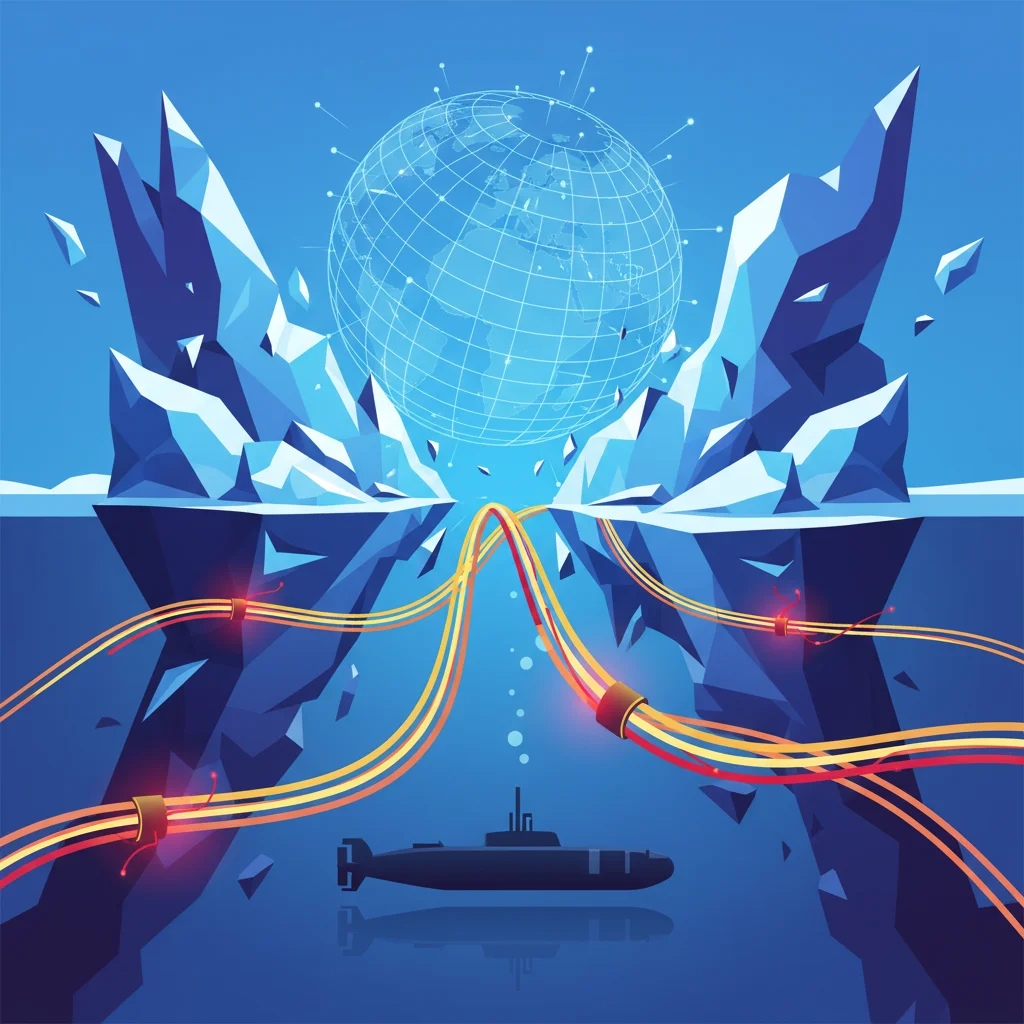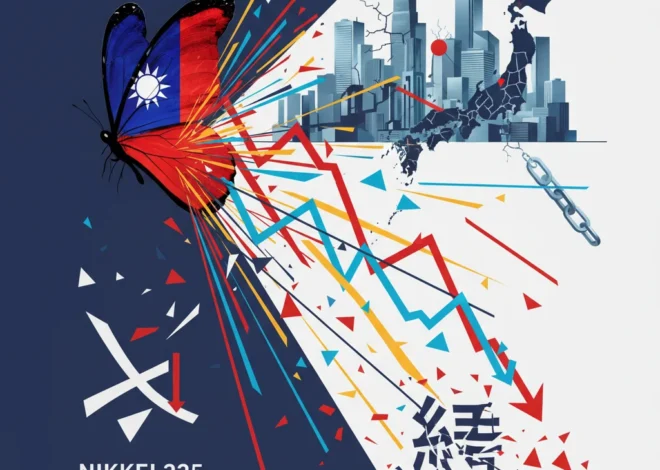
The Arctic’s New Cold War: Why Undersea Cables Are the Frontline for the Global Economy
The Invisible Arteries of Global Finance Are Under Threat
In the vast, hyper-connected world of modern finance, trillions of dollars flash across the globe in milliseconds. This river of capital, which powers everything from stock market trades to your morning coffee purchase, doesn’t travel through the air or via satellite. Instead, it flows through a network of undersea fiber-optic cables—the unsung, yet indispensable, arteries of the global economy. Over 95% of all international data and voice traffic, including an estimated $10 trillion in daily financial transactions, relies on this sprawling submarine network. Now, a new and insidious threat to this critical infrastructure is emerging from the icy waters of the far north.
Arctic leaders are sounding the alarm about the growing risk of “hybrid warfare,” a form of conflict that blurs the lines between war and peace. It’s a battle fought not with armies on a field, but through sabotage, cyber-attacks, and the disruption of critical infrastructure. As melting ice opens up new strategic shipping lanes and access to resources, the Arctic is transforming from a desolate wasteland into a geopolitical hotspot. And the first shots in this new cold war may be aimed at the vital data cables lying on the seabed.
A recent warning shot comes from the remote Faroe Islands, a self-governing archipelago in the North Atlantic. Strategically positioned between Iceland and Norway, its leaders are in talks to add an extra undersea internet cable, a move explicitly designed to safeguard their communications from potential sabotage. This isn’t just a local issue; it’s a microcosm of a global vulnerability that has profound implications for international finance, investing, and the stability of the entire digital economy.
Hybrid Warfare: The Grey-Zone Threat to Economic Stability
To understand the danger, we must first grasp the nature of hybrid warfare. Unlike conventional conflict, its tactics are designed to be deniable, ambiguous, and below the threshold that would typically trigger a military response. These actions aim to destabilize and weaken an adversary without firing a single shot in the traditional sense. In the context of the Arctic, this means targeting the physical infrastructure that underpins Western economies.
Russia, with its significant military and commercial interests in the region, has been identified by Western officials as a primary actor. Its naval and “research” vessels have been observed mapping the location of critical undersea infrastructure, including cables and pipelines. An attack could range from a physical cut by a submarine or a specially equipped surface ship to a sophisticated cyber-attack targeting the landing stations where the cables connect to terrestrial networks. The disruption caused by a severed cable is immense. In 2022, a damaged cable left the UK’s Shetland Islands without internet or phone service, demonstrating the real-world impact on a smaller scale. Now, imagine that disruption scaled up to a major financial hub.
The following table illustrates the distinct nature of this threat compared to conventional military action:
| Aspect | Conventional Warfare | Hybrid Warfare (Infrastructure Focus) |
|---|---|---|
| Tactic | Direct military engagement (airstrikes, naval battles, ground troops) | Covert sabotage, cyber-attacks, disinformation, political subversion |
| Attribution | Clear and immediate (state vs. state) | Ambiguous and deniable (“mysterious explosion,” “fishing trawler accident”) |
| Primary Target | Military assets, government centers, industrial capacity | Critical civilian infrastructure (energy pipelines, communication cables, financial networks) |
| Economic Impact | Massive, overt destruction of physical capital and human life | Systemic disruption, loss of confidence, market volatility, targeted economic pain |
This “grey-zone” approach makes it incredibly difficult to formulate a response. Is a cut cable an act of war or an unfortunate accident? This ambiguity is the strategy’s greatest strength and poses a direct challenge to the international financial system, which is built on a foundation of stability, predictability, and trust.
The Faroe Islands: A Canary in the Coal Mine
The proactive measures being taken by the Faroe Islands provide a crucial case study in risk mitigation. As a hub for several key transatlantic cables, the archipelago is acutely aware of its strategic importance and vulnerability. According to Bárður á Steig Nielsen, the former prime minister and current opposition leader, “If the cables to the Faroes are cut, the whole country is shut down in a minute (source).”
Their solution? Redundancy. By investing in an additional cable, they are diversifying their connectivity, ensuring that a single point of failure won’t cripple their nation. This is a fundamental principle of sound investing and risk management applied to national infrastructure. Just as a savvy investor diversifies a stock portfolio to protect against a downturn in one sector, nations and corporations must now diversify their physical data routes to protect against geopolitical threats. This initiative highlights a growing trend: the convergence of national security and economic policy. Securing data infrastructure is no longer just an IT issue; it is a paramount concern for maintaining economic sovereignty and stability.
The Shockwaves Across the Global Financial System
The implications of a coordinated attack on this undersea network are staggering and would ripple through every corner of the global financial landscape. This is not a theoretical exercise; it’s a tangible threat to the operational integrity of the entire system.
Stock Market and High-Frequency Trading
The modern stock market is a game of microseconds. High-frequency trading (HFT) algorithms execute millions of orders in the blink of an eye, relying on the lowest possible latency to capitalize on tiny price discrepancies. A severed or degraded cable connecting major financial centers like New York and London would introduce delays, rendering many HFT strategies useless. More dangerously, it could create informational asymmetry, where some market participants have access to data while others are flying blind. This could lead to flash crashes, unprecedented volatility, and a complete loss of faith in market fairness. The very concept of efficient trading would be jeopardized.
Banking, Fintech, and Global Payments
The global banking system is a deeply interconnected network. Every day, trillions of dollars move between banks via systems like SWIFT, all of which depend on the undersea cable network. A significant disruption could halt cross-border payments, freeze credit markets, and prevent banks from settling transactions. The burgeoning fintech sector is even more vulnerable. Companies offering services from digital payments to cloud-based core banking platforms are entirely dependent on constant, reliable internet connectivity. An outage isn’t an inconvenience; it’s an existential threat that could wipe out value and disrupt services for millions of customers. This highlights a critical vulnerability in the evolution of financial technology.
Blockchain and the Digital Asset Economy
While blockchain technology is often praised for its decentralized nature, it is not immune. The network of nodes that validate transactions and maintain the ledger must communicate with each other. This communication happens over the internet, which runs on physical cables. A major disruption could partition the network, potentially leading to conflicting versions of the blockchain (a “chain split”). This would create chaos for cryptocurrencies and other digital assets, undermining the core promise of a single, immutable source of truth. The decentralization of the software is irrelevant if the underlying physical communication layer is centralized and vulnerable.
Venezuela on the Brink: An Economic Autopsy and Its Impact on Global Finance
Investing in Resilience: A New Economic Imperative
This emerging threat landscape is creating a new economic imperative: investing in resilience. This presents both challenges and significant opportunities for investors and business leaders. The focus is shifting from pure efficiency to security and redundancy, creating new markets and rewarding forward-thinking companies.
Investment is pouring into several key areas. First is the reinforcement of the cable network itself. This includes “dark cables” with no publicly disclosed route, increased physical protection for landing stations, and the development of faster, more efficient repair capabilities. Companies specializing in marine engineering and subsea technology are poised for growth.
Second, alternative communication systems are gaining prominence. Low-Earth Orbit (LEO) satellite networks, such as SpaceX’s Starlink, offer a viable alternative that is not susceptible to undersea sabotage. While currently not a full replacement for the sheer bandwidth of fiber optics, they provide a crucial layer of redundancy for critical financial and government communications. This space-based infrastructure represents a new frontier for finance and investing.
Finally, the cybersecurity and financial technology sectors are racing to develop solutions. This includes advanced AI-powered network monitoring to detect threats and sophisticated software that can instantly reroute data traffic in the event of an outage. New insurance products are also being developed to help companies hedge against the financial losses from this specific type of infrastructure failure. According to one Arctic official, the threat is forcing a re-evaluation of security, stating, “We have been far too naive (source).” That naivety is now being replaced by a multi-billion dollar push for a more resilient global network.
The Great Auto-Shift: Why a Shipping CEO's Warning Spells a New Era for Global Markets
Conclusion: The New Price of a Connected World
The warnings from Arctic leaders and the actions of the Faroe Islands are not isolated events. They are the leading edge of a fundamental shift in how we must view the relationship between geopolitics, technology, and the economy. The invisible infrastructure that we have long taken for granted is now a contested space in a global power struggle. For investors, finance professionals, and business leaders, the key takeaway is clear: systemic risk is no longer confined to financial contagion or market bubbles. It now includes the physical severing of the data lines that hold our digital world together.
Understanding and planning for these new “grey-zone” threats is no longer optional. It is essential for navigating the complexities of the 21st-century economy. The stability of our stock markets, the future of banking and fintech, and the functioning of global trade depend on our ability to secure not just our data, but the very cables that carry it through the dark, cold depths of the world’s oceans.


